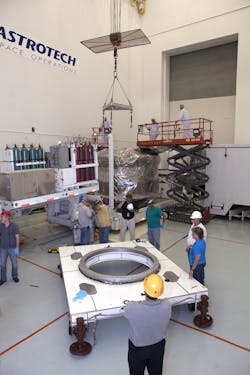With the ever-increasing demand on output and return on investment in today’s workplace, employees in the occupational setting remain at risk of acute and overuse on-the-job injuries. Often, their work requires special skills such as heavy lifting, carrying, repetitive movement and physical stress.
Lost days from work can have a significant impact on a company’s bottom line and on the worker’s productivity.
“Athletic trainers’ expertise in musculoskeletal health makes them a vital part of an occupational health care team whether working as independent contractors or employed through a company, clinic, hospital or other facility,” says NATA President Jim Thornton, MA, ATC, CES.
In recognition of Allied Health Professions Week (Nov. 2-8), the National Athletic Trainers’ Association sheds new light on the occupational health environment and the financial benefits to employers who have athletic training programs on-site.
Sobering Statistics
According to OSHA:
- 40 percent of total injuries and illnesses are strains and tears, and an additional 29 percent are musculoskeletal disorders.
- Median lost time for specific disorders include carpel tunnel syndrome (27 days); tendonitis (14 days); musculoskeletal disorders (11 days); sprains, strains and tears (10 days); and soreness or back pain (8 days).
- Work-related musculoskeletal disorders in the U.S. account for more than 600,000 injuries (34 percent of lost workdays).
- Employees spend as much as $20 billion a year on musculoskeletal work related injuries and five times that for indirect costs (hiring, training replacements).
More than 90 percent of respondents indicated employee days away from work decreased by 25 percent or more at their company;
- Almost half of the companies had emergency room costs reduced by 50 percent or more;
- More than 50 percent reported a decrease in costs associated with workplace injuries.
Case Histories: Injury Prevention Programs
At the Southcoast Health Injury Prevention Program in Dartmouth, Mass., Ergonomics Manager Joe Scott, MS, ATC, LAT, and a team of 13 athletic trainers conduct internal employee work-station ergonomic evaluations, on-site injury care and triage as well as prevention and wellness programs to ensure the occupational safety of the staff.
“By identifying risk factors and putting controls in place to reduce employee injuries, we can promote and sustain healthy lifestyles. This has a positive impact on our health system and reduces overall job-related injuries and time loss from work,” adds Scott. “Recognizing the limited time a patient often now spends with a doctor, athletic trainers also serve as physician extenders in the occupational environment to provide patients with the necessary education and tools they need to return to work and physical activity.”
Southcoast Health has tracked a 30 percent decrease in overall musculoskeletal disorders within its own health care system in the past year. The program now includes screenings, concussion management and expanded prevention protocols.
Southcoast Health also works with 100 companies – including Stop & Shop Distribution Center and Ashland Freetown – doing on-site ergonomic assessments and developing education and rehab programs that address the physical demands of the job.
“The athletic trainer from Southcoast Health has been a tremendous asset to our employees – in following up on injured workers and providing feedback and instruction on the floors to the staff, he has provided many of our workers with guidance and instructions to perform their jobs more safely and efficiently,” said Kelly Gardner, health and safety coordinator, Stop & Shop Distribution Center, Freetown, Mass.
NASA Offers Injury Prevention and Rehab to Kennedy Space Center Employees
“Our program was created to offer high-quality physical medicine and musculoskeletal injury prevention and rehab services to industrial athletes at the Kennedy Space Center,” said Erik T. Nason, MS, ATC, LAT, currently employed by InoMedic Health Applications. He has been the athletic trainer for the RehabWorks program at the Kennedy Space Center in Florida for the past 17 years.
Established in 1997, RehabWorks is staffed solely by athletic trainers and offers a team approach to return employees to work and the physical activities they enjoy in a safe and effective manner. Its staff commonly treats space center employees with work and non-work-related injuries, including cumulative trauma disorders, joint replacements, rotator cuff repairs, low back pain, ACL reconstructions and sprains and strains. RehabWorks also plays a vital role in injury management through communications with referring physicians, workers’ compensation representatives, contract case managers and safety and health personnel.
“As medical director of the Kennedy Space Center and as an athlete who regularly competes in long-distance cycling events, I place a high value on the contributions … athletic trainers have made to the health and recovery of our industrial athletes,” said Leon “Skip” Beeler, MD, medical director, InoMedic Health Applications, Kennedy Space Center.
Free to employees, the on-site program reduces travel time to and from rehab, maintains the employees’ normal work routine during the rehab process, decreases lost work time and increases job productivity.
“The estimated time away for the office for any off-site rehabilitation is four hours,” adds Nason. “We’ve calculated an average weighted hourly salary to be $63. This translates to a weighted salary loss of $252 per off-site rehab appointment.”
The RehabWorks program saves lost work hours and NASA and its contractors an average $750,000 annually. Also, the employee’s insurance company is not billed, and no copays are collected. RehabWorks has been recognized as a Voluntary Protection Programs Participant Association (VPPPA) Best Practice Facility, as designated by OSHA, which ensures a gold standard of care.
Trainers Help Fairfax County (Virginia) Police Department Employees
The Injury Care and Prevention Program of the Fairfax County (Virginia) Police Department is based at the County Criminal Justice Academy. Common injuries include sprains and strains from physical training and job-related activities. Frequent cause of injuries includes vehicle rear or head-on collision, pursuing suspects on foot or “hands-on” contact with unwilling offenders.
“Utilizing an athletic trainer in the academy setting has proven to reduce overall medical costs by 49.5 percent and musculoskeletal medical costs by 86.3 percent,” says Nancy Burke, MS, ATC, VATL, athletic trainer, Fairfax County Police Department. “And, by having the athletic trainer treating sworn and civilian employees in a large county police force, we’ve tracked reduction of overall medical costs by 22.05 percent and musculoskeletal medical costs by 21.2 percent.”
There also has been a reduction in time loss for duty and non-duty injuries, and the athletic trainer has introduced concussion awareness and baseline testing. Improvements in health and wellness education have led to claims. Expediting access to workers’ compensation and personal physicians, as well as ongoing positive relationships with third-party administrators, results in significant employee support for the athletic trainer.
“The high standard for care and treatment is deserving of the department’s police officers. Bringing together a new and innovative way to provide immediate care and response, while reducing costs involved with potential significant injuries is a win/win,” said Teri Flynn, the risk manager for Fairfax County.





